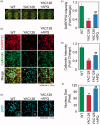Modulation of SETDB1 activity by APQ ameliorates heterochromatin condensation, motor function, and neuropathology in a Huntington's disease mouse model
- PMID: 33771089
- PMCID: PMC8008885
- DOI: 10.1080/14756366.2021.1900160
Modulation of SETDB1 activity by APQ ameliorates heterochromatin condensation, motor function, and neuropathology in a Huntington's disease mouse model
Abstract
The present study describes evaluation of epigenetic regulation by a small molecule as the therapeutic potential for treatment of Huntington's disease (HD). We identified 5-allyloxy-2-(pyrrolidin-1-yl)quinoline (APQ) as a novel SETDB1/ESET inhibitor using a combined in silico and in vitro cell based screening system. APQ reduced SETDB1 activity and H3K9me3 levels in a HD cell line model. In particular, not only APQ reduced H3K9me3 levels in the striatum but it also improved motor function and neuropathological symptoms such as neuronal size and activity in HD transgenic (YAC128) mice with minimal toxicity. Using H3K9me3-ChIP and genome-wide sequencing, we also confirmed that APQ modulates H3K9me3-landscaped epigenomes in YAC128 mice. These data provide that APQ, a novel small molecule SETDB1 inhibitor, coordinates H3K9me-dependent heterochromatin remodelling and can be an epigenetic drug for treating HD, leading with hope in clinical trials of HD.
Keywords: Histone H3K9me3-specific transferase; Huntington’s disease; SETDB1; medium spiny neuron; motor function.
Conflict of interest statement
No potential conflict of interest was reported by the author(s).
Figures










References
-
- A novel gene containing a trinucleotide repeat that is expanded and unstable on Huntington's disease chromosomes. The Huntington's Disease Collaborative Research Group. Cell 1993;72:971–83. - PubMed
-
- Beal MF, Ferrante RJ.. Experimental therapeutics in transgenic mouse models of Huntington's disease. Nat Rev Neurosci 2004;5:373–84. - PubMed
MeSH terms
Substances
Grants and funding
LinkOut - more resources
Full Text Sources
Other Literature Sources
Medical
